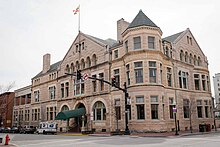The Maryland Club is a private social club in Baltimore, Maryland. Founded in 1857 as an exclusive men's club, it is today one of the oldest surviving such clubs. Its 1891 Romanesque clubhouse, located at 1 East Eager Street in the Mount Vernon neighborhood, was listed on the National Register of Historic Places in 2024.
 A view of the Maryland Club in Baltimore | |
| Formation | 1857 |
|---|---|
| Location | |
| Website | www |
The Club’s members have traditionally been among the region’s most prominent business, professional, civic and nonprofit leaders. Membership is by invitation only. The Club's website says it wants a diverse membership of outstanding individuals regardless of race, gender, religion, ethnicity or sexual orientation.[1]
In 1861, the club supported the secession of the Confederate States of America.[2] The club was closed by Union troops during the American Civil War. General Lew Wallace outraged local residents by turning the club building into a shelter for homeless former slaves.[3] The club re-opened after the war.[2] The club opposed Prohibition and flouted the law through the use of private lockers.[2] After a 1995 fire nearly destroyed its building, the club restored its architectural and aesthetic elements. In 2019, a major renovation added squash facilities, improved the exercise area, added a bistro-style restaurant, and made other system upgrades.
In 1988, the club began accepting Jews as members. [4]
Notable members
edit- Jérôme Napoléon Bonaparte, the first president of the club[5]
- William Cabell Bruce[6]
- Charles W. Field[7]
- Charles F. Mayer[8]
- Charles F. Mayer (railroad president), nephew of the above
- 45th Governor of the State of Maryland, Edwin Warfield[9]
- James T. Woodward[10]
- Glenn L. Martin[11]
See also
editReferences
edit- ^ "Home - Maryland Club". www.marylandclub1857.org. Retrieved 2021-06-04.
- ^ a b c "History". Maryland Club.
- ^ Brugger, Robert J. (1988). Maryland, A Middle Temperament: 1634-1980. Baltimore, Maryland: Johns Hopkins University Press. p. 364. ISBN 9780801854651. Retrieved 15 July 2015.
- ^ Pietila, Anteri J. (2010). Not in My Neighborhood How Bigotry Shaped a Great American City Maryland, A Middle Temperament: 1634-1980. Chicago,Illinois: Ivan R. Dee Publisher. p. 140. ISBN 978-1-56663-843-2.
- ^ Gunning, Brooke; O'Donovan, Molly (2000). Baltimore's Halcyon Days. Arcadia Publishing. p. 75. ISBN 9780738506319. Retrieved 15 July 2015.
- ^ Steiner, Bernard C. (1907). Men of Mark in Maryland: Biographies of Leading Men of the State. Washington, D.C.: Johnson-Wynne Company. p. 69. Retrieved 15 July 2015.
- ^ Shepherd, Henry Elliot (1893). History of Baltimore, Maryland. S.B. Nelson. p. 865. Retrieved 15 July 2015.
- ^ Shepherd, Henry Elliot (1893). History of Baltimore, Maryland. S.B. Nelson. p. 953. Retrieved 15 July 2015.
- ^ Steiner, Bernard C. (1907). Men of Mark in Maryland: Biographies of Leading Men of the State. Washington, D.C.: Johnson-Wynne Company. p. 30. Retrieved 15 July 2015.
- ^ "James T. Woodward, The Banker, Is Dead" (PDF). New York Times. April 11, 1910. Retrieved 15 July 2015.
- ^ The Maryland Club, A History of Food and Friendship in Baltimore, 1857-1997; Pg 90, Robert J. Brugger